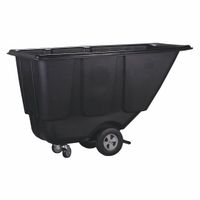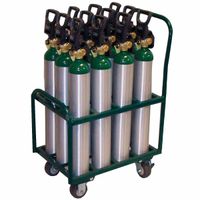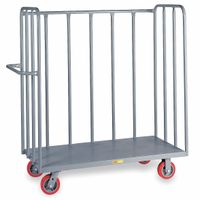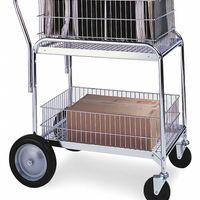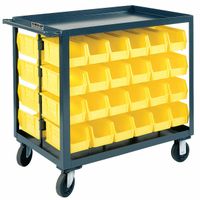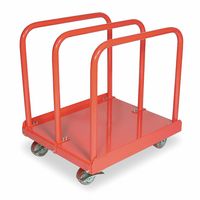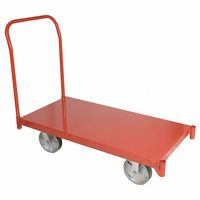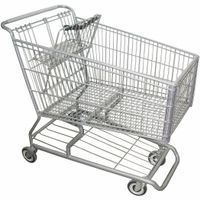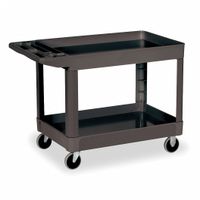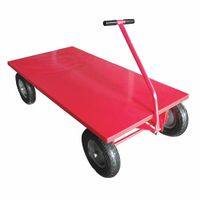Call +(254) 703 030 000 / 751 483 999 / 721 704 777
- Home
- Material Handling
- Transporting
- Carts Trucks
.....Read More
Frequently Asked Questions
What are the different types of carts and trucks used for moving items?
There are several types of carts and trucks designed for moving items, each suited for specific tasks and environments:
1. **Hand Trucks (Dollies):** These L-shaped carts have two wheels and a small platform to slide under items. They are ideal for moving boxes and appliances.
2. **Platform Trucks:** Featuring a flat platform on four wheels, these are used for transporting heavy or bulky items in warehouses and retail settings.
3. **Pallet Jacks:** Used to lift and move pallets, these come in manual and electric versions. They are essential in warehouses for palletized goods.
4. **Utility Carts:** These multi-shelf carts are used in various settings, from offices to hospitals, for transporting smaller items.
5. **Furniture Dollies:** Flat, four-wheeled platforms used for moving heavy furniture. They often have a carpeted surface to protect items.
6. **Service Carts:** Equipped with multiple shelves, these are used in hospitality and food service industries for transporting dishes, food, and supplies.
7. **Drum Trucks:** Specifically designed for moving cylindrical items like drums and barrels, featuring a curved back to secure the load.
8. **Tilt Trucks:** Used for waste management and material handling, these have a large container that can be tilted for easy unloading.
9. **Stock Carts:** Used in retail and warehouses for restocking shelves, these have multiple shelves and sometimes a ladder.
10. **Convertible Hand Trucks:** These can switch between a two-wheel hand truck and a four-wheel cart, offering versatility for different loads.
11. **Garden Carts:** Designed for outdoor use, these have large wheels and are used for transporting soil, plants, and tools.
12. **Flatbed Carts:** Similar to platform trucks but often larger, used for transporting oversized items.
Each type of cart or truck is designed to improve efficiency and safety in moving items across various environments.
How do shelf and utility carts differ from stock trucks?
Shelf and utility carts and stock trucks are both used for transporting goods, but they differ in design, functionality, and application.
Shelf and utility carts are typically designed with multiple shelves or tiers, allowing for the organized transport of various items. They are often used in environments like offices, libraries, and hospitals where smaller, lighter items need to be moved efficiently. These carts are usually equipped with wheels for easy maneuverability and may include features like handles, brakes, or bins for added convenience. The focus is on accessibility and organization, making them ideal for tasks that require frequent loading and unloading of items.
Stock trucks, on the other hand, are more robust and are designed for heavier loads. They are commonly used in warehouses, factories, and retail environments where bulkier and heavier items need to be transported. Stock trucks often have a flat platform or a cage-like structure to accommodate larger goods. They are built to handle more weight and may include features like reinforced frames, larger wheels, and sometimes motorized components to assist with the movement of heavy loads. The emphasis is on durability and capacity, making them suitable for industrial and commercial applications.
In summary, while both shelf and utility carts and stock trucks serve the purpose of transporting goods, shelf and utility carts are more suited for lighter, organized transport in less demanding environments, whereas stock trucks are designed for heavy-duty use in industrial settings.
What are the benefits of using hand trucks for moving heavy loads?
Hand trucks offer several benefits for moving heavy loads:
1. **Injury Prevention**: Hand trucks reduce the risk of injuries such as strains and sprains by minimizing the physical effort required to lift and carry heavy items. They allow for proper posture and ergonomics, decreasing the likelihood of back injuries.
2. **Efficiency**: They enable quicker and more efficient transportation of goods. With the ability to carry multiple items at once, hand trucks reduce the number of trips needed, saving time and increasing productivity.
3. **Versatility**: Hand trucks are versatile and can be used in various environments, including warehouses, offices, and homes. They can handle different types of loads, from boxes to appliances, making them suitable for diverse tasks.
4. **Load Capacity**: Designed to carry heavy weights, hand trucks can handle loads that would be difficult or impossible for a person to carry alone. This capability is crucial for moving bulky or awkwardly shaped items.
5. **Durability**: Made from robust materials like steel or aluminum, hand trucks are built to withstand heavy use and harsh conditions, ensuring longevity and reliability.
6. **Maneuverability**: Equipped with wheels, hand trucks offer easy maneuverability, even in tight spaces. They can navigate through narrow aisles and around obstacles with ease.
7. **Cost-Effectiveness**: Investing in a hand truck can be more economical than hiring additional labor for moving tasks. It reduces the need for multiple workers and can lower operational costs over time.
8. **Storage and Portability**: Many hand trucks are foldable or have compact designs, making them easy to store and transport when not in use.
Overall, hand trucks enhance safety, efficiency, and convenience in moving heavy loads, making them an essential tool in various settings.
How do bulk container trucks and tilt trucks function?
Bulk container trucks and tilt trucks are specialized vehicles designed for transporting large quantities of goods efficiently.
Bulk container trucks are primarily used for transporting loose bulk materials such as grains, coal, or aggregates. These trucks are equipped with large containers or hoppers that can be loaded from the top and unloaded from the bottom. The containers are often made of durable materials like steel or aluminum to withstand the weight and abrasiveness of the materials. The unloading process typically involves opening a gate or chute at the bottom of the container, allowing gravity to assist in the discharge of the materials. Some bulk container trucks may also have pneumatic systems to aid in unloading, especially for fine materials like powders.
Tilt trucks, on the other hand, are designed to transport and unload materials that are contained in bins or smaller containers. These trucks have a tilting mechanism that allows the entire bed or container to be lifted and tilted, facilitating the easy discharge of contents. The tilting action is usually powered by hydraulic systems, providing the necessary force to lift and tilt heavy loads. Tilt trucks are commonly used in waste management, construction, and agriculture for transporting materials like soil, debris, or harvested crops. The tilting mechanism ensures that materials are unloaded quickly and efficiently, reducing manual labor and time.
Both types of trucks are essential in industries that require the movement of large volumes of materials, offering efficiency and convenience in loading and unloading processes.
What are platform trucks used for?
Platform trucks are versatile material handling tools used primarily for transporting heavy or bulky items within warehouses, factories, retail environments, and other industrial settings. They consist of a flat platform mounted on wheels, often with a handle for pushing or pulling. These trucks are designed to improve efficiency and safety in moving goods over short distances.
Key uses of platform trucks include:
1. **Material Transport**: They facilitate the movement of raw materials, finished products, or components between different areas of a facility, reducing the need for manual lifting and carrying.
2. **Loading and Unloading**: Platform trucks assist in loading and unloading goods from delivery vehicles, streamlining the process and minimizing the risk of injury.
3. **Order Picking**: In retail and warehouse settings, platform trucks are used for picking and collecting items for order fulfillment, enhancing productivity and accuracy.
4. **Inventory Management**: They aid in organizing and relocating inventory, making stocktaking and inventory control more efficient.
5. **Event Setup**: In event management, platform trucks help transport equipment, decorations, and supplies to and from venues, ensuring smooth setup and teardown.
6. **Maintenance and Cleaning**: Facilities use platform trucks to carry tools, cleaning supplies, and maintenance equipment, facilitating quick and efficient upkeep.
7. **Custom Applications**: Some platform trucks are customized for specific tasks, such as carrying oversized or irregularly shaped items, by adding side rails, shelves, or specialized attachments.
Overall, platform trucks are essential for enhancing operational efficiency, reducing physical strain on workers, and ensuring the safe transport of goods in various industries.
How do security trucks prevent theft and tampering?
Security trucks employ a variety of measures to prevent theft and tampering. These include:
1. **Armored Construction**: The trucks are built with reinforced steel and bullet-resistant glass to withstand attacks and prevent unauthorized access.
2. **Secure Locking Systems**: Advanced locking mechanisms, often electronically controlled, ensure that only authorized personnel can access the cargo area.
3. **GPS Tracking**: Real-time GPS tracking allows for constant monitoring of the truck's location, enabling quick response in case of deviation from the planned route.
4. **Surveillance Cameras**: Onboard cameras provide continuous video surveillance, both inside and outside the vehicle, to deter and document any suspicious activity.
5. **Alarm Systems**: High-decibel alarms are triggered by unauthorized entry attempts or tampering, alerting the driver and security personnel.
6. **Two-Way Communication**: Secure communication systems keep the driver in constant contact with the control center, allowing for immediate reporting of any issues.
7. **Route Planning and Diversification**: Routes are carefully planned and often changed to avoid predictability, reducing the risk of ambushes.
8. **Security Personnel**: Trained armed guards accompany the truck, providing an immediate deterrent to potential thieves.
9. **Time-Delay Safes**: Cash and valuables are stored in safes with time-delay mechanisms, preventing immediate access even if the truck is breached.
10. **Driver Training**: Drivers receive specialized training in defensive driving and emergency protocols to handle potential threats effectively.
11. **Remote Disabling**: Some trucks are equipped with systems that allow remote disabling of the vehicle in case of hijacking.
These combined measures create a robust security framework that significantly reduces the risk of theft and tampering.
What are the specific uses of medical and retail carts?
Medical carts are essential in healthcare settings for enhancing efficiency and patient care. They are used for:
1. **Medication Management**: Securely store and transport medications, reducing errors and ensuring timely administration.
2. **Patient Records**: Provide mobile access to electronic health records, facilitating real-time data entry and retrieval.
3. **Emergency Response**: Equipped with life-saving equipment and medications for rapid response in emergencies.
4. **Procedure Support**: Carry necessary tools and supplies for various medical procedures, improving workflow.
5. **Telemedicine**: Support remote consultations with integrated video conferencing tools.
Retail carts are vital in retail environments for improving customer experience and operational efficiency. They are used for:
1. **Merchandise Display**: Showcase products attractively, enhancing visibility and encouraging purchases.
2. **Inventory Management**: Assist in restocking shelves and managing inventory efficiently.
3. **Point of Sale**: Mobile checkout stations that reduce wait times and improve customer service.
4. **Promotional Activities**: Used in events or promotions to highlight special offers or new products.
5. **Customer Assistance**: Provide a platform for customer service representatives to assist shoppers on the floor.
